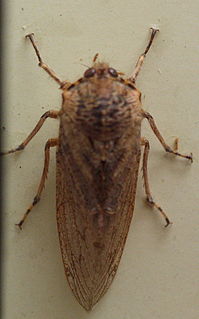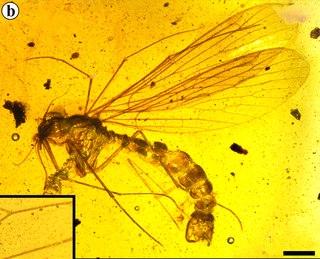
Scelidosaurus is a genus of herbivorous armoured ornithischian dinosaur from the Jurassic of England.

Tanyderidae, sometimes called primitive crane flies, are long, thin, delicate flies with spotted wings, superficially similar in appearance to some Tipulidae, Trichoceridae, and Ptychopteridae. Most species are restricted in distribution. They are found in many parts of the world, including North America, South America, Africa, Australia, New Zealand, and various islands in the Pacific Ocean. Adults are usually found hanging from vegetation near streams. Larvae are found either in sandy stream margins or in wet, rotten wood. Fossil species are known.

The Cerophytidae are a family of Coleoptera known as the rare click beetles. Adults are infrequently encountered, and larvae are found within wood, where they are believed to feed on fungi. The family contains over 20 species in five genera, primarily distributed in the New World: 17 fossil genera are known extending to the Early Jurassic.

Eomeropidae is a family of aberrant, flattened scorpionflies represented today by only a single living species, Notiothauma reedi, known from the Nothofagus forests in southern Chile, while all other recognized genera in the family are known only as fossils, with the earliest definitive fossil known from from Liassic-aged strata, and the youngest from Paleogene-aged strata.

The Tettigarctidae, known as the hairy cicadas, are a small relict family of primitive cicadas. Along with more than 20 extinct genera, Tettigarctidae contains a single extant genus, Tettigarcta, with two extant species, one from southern Australia and one from the island of Tasmania. Fossil taxa include Paratettigarcta from the Miocene of New Zealand, Meuniera from the Paleocene of France, and Sanmai from the Late Jurassic of China, and Maculaferrum of early Late Cretaceous Canada.Tettigarcta are the closest living relatives of the true cicadas.

The Blue Lias is a geological formation in southern, eastern and western England and parts of South Wales, part of the Lias Group. The Blue Lias consists of a sequence of limestone and shale layers, laid down in latest Triassic and early Jurassic times, between 195 and 200 million years ago. The Blue Lias is famous for its fossils, especially ammonites.

Coptoclavidae is an extinct family of aquatic beetles in the suborder Adephaga. The Coptoclavidae lived from the Triassic to the Early Cretaceous. Coptoclavidae is a clade of Dytiscoidea. The increase in the teleost fish population and the competition of Gyrinidae and Dytiscidae is believed to have caused their extinction.
Brochocoleus is an extinct genus of beetles in the family Ommatidae, known from the Early Jurassic to the Early Late Cretaceous. 9 species are currently recognised, with many species being reassigned to other genera by Kirejtshuk's major systematic revision in 2020.

Omma is a genus of beetles in the family Ommatidae. Omma is an example of a living fossil. The oldest species known, O. liassicum, lived during the final stage of the Triassic (Rhaetian), followed by several other species from Europe and Asia until after O. attenuatum from the Lower Cretaceous, the genus then reappears in the Burmese amber during the Cenomanian, then disappears from the fossil record for the remaining 100 million years until today, with one species endemic to Australia, three other extant species that were formerly part of this genus were moved to the separate genus Beutelius in 2020. The extant Omma stanleyi is strongly associated with wood, being found under Eucalyptus bark and exhibiting thanatosis when disturbed. Its larval stage and many other life details are unknown due to its rarity. Males are typically 14-20 mm in length, while females are 14.4-27.5 mm. Omma stanleyi occurs throughout eastern Australia from Victoria to Central Queensland.
Priscaenigma is an extinct genus of snakefly of the Priscaenigmatidae family which was described by Whalley in 1985. The fossils were found on flatstones at Black Ven in Charmouth, Dorset at 50.7°N 2.9°W in a marine environment of the Charmouth Mudstone Formation. The fossils were collected by J. F. Jackson between 1961 and 1963. Its sister taxa is Hondelagia. The genus contains one species, the extinct Priscaenigma obtusa, also described by Whalley in 1985. Its forewing is 12.6 centimetres (5.0 in) in length. Only a forewing was found when the species was discovered.

The Charmouth Mudstone Formation is a geological formation in England. It preserves fossils dating back to the early part of the Jurassic period (Sinemurian–Pliensbachian). It forms part of the lower Lias Group. It is most prominently exposed at its type locality in cliff section between Lyme Regis and Charmouth but onshore it extends northwards to Market Weighton, Yorkshire, and in the subsurface of the East Midlands Shelf and Wessex Basin. The formation is notable for its fossils, including those of ammonites and marine reptiles and rare dinosaur remains. The formation played a prominent role in the history of early paleontology, with its Lyme Regis-Charmouth exposure being frequented by fossil collectors including Mary Anning.
Locustopsidae is an extinct family of grasshoppers in the order Orthoptera. There are about 17 genera and more than 60 described species in Locustopsidae.
Protogryllidae is an extinct family of crickets in the order Orthoptera. There are about 8 genera and more than 20 described species in Protogryllidae.
Thueringoedischiidae is an extinct family of long-horned Orthoptera. There are at least three genera and three described species in Thueringoedischiidae.
Xyronotidae is a family of grasshoppers in the order Orthoptera. There are at least two genera and four described species in Xyronotidae.

Pseudopolycentropodidae is an extinct family of scorpionflies known from the Mesozoic. Fossils are known from the Middle Triassic (Anisian) to the early Late Cretaceous (Cenomanian). It is part of Mesopsychoidea, a group of scorpionflies with siphonate proboscis. They are suggested to have been feeders of liquid pollination drops produced by gymnosperms.
Dermapteridae is an extinct family of earwigs known from the Late Triassic to Mid Cretaceous, it is part of the extinct suborder Archidermaptera, alongside Protodiplatyidae and Turanovia. It was first named as a subfamily by Vishniakova in 1980, and elevated to family status by Engel in 2003 without discussion.
Mesoblattinidae is an extinct family of cockroaches known from the Mesozoic. It was formerly considered a wastebasket taxon for Mesozoic cockroaches, but the family has subsequently been better defined, with many taxa transferred to Caloblattinidae. It is considered to have close affinities with Blattidae and Ectobiidae, as well as possibly Blaberidae.
Liassocupes is an extinct genus of Ommatid beetle from the Jurassic period. The only species is Liassocupes parvus. It is known from compression fossils found at Flatstones near Charmouth in the Sinemurian aged part of the Charmouth Mudstone Formation, Dorset Other species previously assigned to the genus include Liassocupes (?) maculatus described by Whalley in 1985 from the same locality, but this was subsequently suggested by Ponomarenko to belong to either Omma or Tetraphalerus and was considered to belong to the genus Brochocoleus by Kirejtshuk, 2020. Another species Liassocupes (?) giganteus also described by Whalley 1985 from the same locality, was found to be a member of the genus Mimemala in the extinct family Schizocoleidae.

Elcanidae are an extinct family of Mesozoic ensiferans. Members of the family are distinguished by the presence of spurs on the distal part of the metatibia, unique among orthopterans, these have been suggested to have been used for controlling gliding or as swimming aids. They are known from the Late Triassic to early Late Cretaceous of Eurasia, North and South America.










